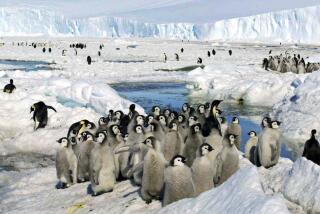Scientists track young penguins via satellite after they leave home
Only about half of the king penguin chicks born in the wild survive to their first birthday, and the ones that don’t make it are most vulnerable in the weeks after they set off on their own. Why are some birds able to survive when so many others aren’t?
To find out, scientists enlisted the help of 18 fledgling king penguins that were getting ready to leave their home colonies. From the Falkland Islands off the southern coast of Argentina, the volunteers included Leo, Jacki, Susi, Gus, Iona, Caldera, Hansueli, WaRu, RuWa and Youngster. From South Georgia Island, a British territory several hundred miles to the east, researchers got help from Dixi, Wicky, Tankini, Ueli, Ursula, Saanenland, Traudel and King Georg.
All of these birds were outfitted with transponders that sent signals to satellites, allowing scientists to track the penguins’ whereabouts, according to a report published Wednesday in the journal PLOS ONE. The 60-gram devices were “hydrodynamically shaped in order to minimise drag and centered on the middle of the back in order not to compromise the penguins’ balance or create excessive hydrodynamic drag.” Scientists attached them to the penguins with black waterproof tape, glue and epoxy.
More than 3 million king penguins live on islands just north of Antarctica, including 450,000 breeding pairs on South Georgia and about 720 breeding pairs on the Falkland Islands. They feed on small fish they catch along the Antarctic Polar Front, a roughly 25-mile-wide zone encircling Antarctica where cold waters sink below warmer ones from the north. When they are caring for hatchlings and stay closer to home, they also hunt for squid.
Though not endangered, king penguins are protected. Permission to tag the young birds was granted by the Animal Ethics Committee of the British Antarctic Survey.
The researchers, from Europe, Argentina and the Falkland Islands, attached transponders to the fledgling penguins in December 2007. The devices emitted signals once a minute for four hours a day. Between Jan. 1 and March 31, 2008, the researchers determined the most accurate position for each day and included that data in their analysis. Altogether, they collected location data for a total of 2,111 penguin-days, with a typical penguin being tracked for 117 days.
The researchers found that the South Georgia penguins exhibited the same types of behavior as the ones from the Falkland Islands. On most days, birds in both groups swam no more than 10 kilometers. But occasional long hauls of more than 100 km per day pushed the daily average up to 45 km. Overall, Ursula stayed closest to home, venturing only 661 km from her colony over 78 days; Youngster traveled the farthest, covering 4,783 km over 261 days.
In the first 20 days of the study, 15 of the 18 penguins headed straight for the Antarctic Polar Front. The Falkland Island penguins arrived from the north, and the South Georgia penguins swam up from the south, according to the study.
Half of the penguins were still checking in after 100 days, including eight that were tracked for more than four months. Seven of those birds headed west to the Pacific Ocean and stayed their until their transponders stopped sending signals. The remaining penguin, Youngster, went east into the Indian Ocean, then headed south toward the winter ice, the researchers reported.
At first, the tagged penguins kept their distance from the adult king penguins, something that has been observed in other species. This may give the fledglings a chance to hone their foraging skills without having to compete with more experienced hunters, the researchers wrote. Similar behaviors have been observed in other bird and mammal species in the Southern Ocean, though by the winter months (late June through late September) the younger animals migrate back into waters where their elders look for food.
King penguins usually spend four or five years “exploring the Southern Ocean” before they settle down and start breeding, the researchers noted.







